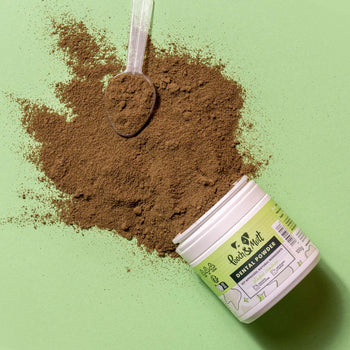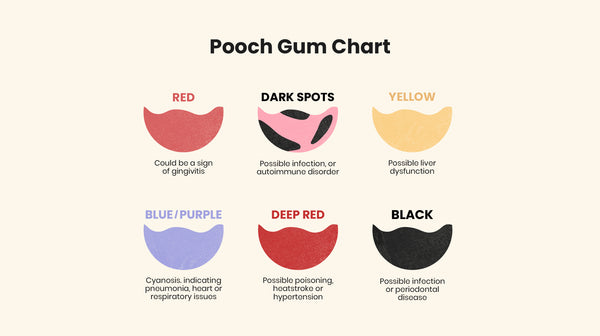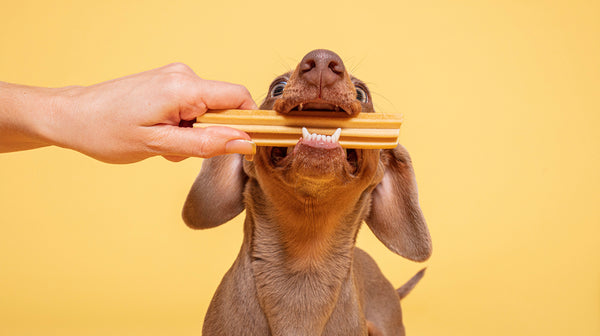
FREE UK DELIVERY ON ORDERS OVER £39.99
Doggy dental issues can have the most hands-on dog owners dumbfounded - especially when it comes to gum health. How exactly should healthy gums look on a dog? What do different coloured gums mean? If your dog has pale gums, is this bad? What should you do next?
Don’t sweat it, as the answers to all your questions about dog gums will be answered here - so read on, and be prepared to get gummy with your pooch.
To start, let’s get into the ideal healthy gums for a dog. Ideally, dogs’ gums should be pink, almost like bubblegum or uncooked salmon. However, some dogs have mottled or dark gums, depending on their breed.
When you press them with your finger, they should go pale for a second then flood back to pink (or mottled) almost immediately. They should also be shiny because they’re wet - this is an indicator that your dog is well hydrated.
Get your pooch into a relaxed position and carefully pull their lips down or up with your fingers, and you should be able to see the condition their gums are in.
We’ve put together a nifty reference chart so you can clearly see what may be an indicator of unhealthy gums, as well as some more info around tip-top pooch gums.
As said above, healthy dog gums should be one of the below colours, wet and slick to the touch (not dry or sticky); and pink gums should quickly flood back to pink when you press them.
Dogs who have the following gum colours may need special attention, as this can indicate underlying health conditions:

Pale or white dog gums may be a concerning prospect for you as a dog owner. You might wonder, what’s the difference between pale gums and normal gums in a dog? The truth is that pale gums are a warning sign for pooch parents - they mean something is wrong, and it’s likely you’ll need to seek emergency vet care.
Here are some of the serious health issues which might lead to pale gums in your dog:
Check your dog’s gums regularly, so that you’re made aware of pale gums as soon as possible. You should also check them as routine if your dog is showing any other signs of illness, pain or distress.
To do this, ensure your dog is calm enough to have their mouth touched. Get them into a safe position and gently push their lips away from their teeth with clean fingers. You should be able to clearly see the colour of your dog’s gums. Push lightly against the gums with your fingers, and test if the former pinkness of the gums floods back. If the gums stay pale, i.e. the colour doesn’t return quickly or at all, this is an emergency situation.

If your pooch has pale gums, immediately get in touch with a vet. As pale gums can be an indication of many different things, take note of any other symptoms in your dog, and be prepared to give a full rundown to a vet.
Once your dog with pale gums is at the vet, they’ll conduct a few tests. Taking into consideration your notes on your dog’s symptoms and behaviour, they’ll physically examine your pooch, and possibly take some blood tests including blood pressure, urine tests or an x-ray.
Further tests may be carried out based on the results, so that your vet can identify the underlying issue in your dog and prescribe suitable treatment.
Since there are so many conditions that lead a dog to have pale gums; an internal injury, ingestion of rat poison, or even cancer - sometimes pale gums aren’t something to prevent, but are more an indication of something that needs urgent attention. In that sense, you could say pale gums are a helpful warning.
That said, there are plenty of ways to keep your dog as safe as possible and ensure they live a healthy lifestyle. This includes taking them for regular check-ups at the vets, supervising them at all times (especially when outside), dog-proofing your house, feeding a nutritionally balanced diet, keeping them well-groomed (including brushing their teeth), and ensuring they get varied, daily exercise.

Aside from strange colours, there are other signs of unhealthy gums to really pay attention to. The following factors could indicate internal health issues in your dog, or might be signs of periodontal disease:
By this point, you’re probably looking for ways to prevent unhealthy gums in your dog. Here are some tips for dog dental care that you can put into action with your pooch straight away…

We’re almost done on dog gums! For easy reference, let’s summarise the signs of healthy gums in a dog:
✔ Salmon or bubblegum pink in colour (or black, or pink with dark patches if they’ve always been this way)
✔ Colour quickly floods back to pink after being pressed
✔ Slippery and wet to indicate hydration
✔ Gums free of abscesses, receding and tartar buildup. If they do have these things, don’t worry as this is very common - but take them to a doggy dentist for a check-up
You should be very familiar with your dog’s mouth, as dental care should be part of a regular grooming routine for your pooch. Gently pull down your dog’s lips with clean fingers, if you can, to check the condition of your dog’s gums regularly - even as often as every week. If your dog is poorly or behaving strangely, check their gums then too.
If your dog’s gums have always been black, for instance if they’re a breed predisposed to black gums such as a Chow-Chow, then black gums are healthy.
However, if your pooch had pink gums at some point, or just pink with dark patches, and the gums have gone entirely black, this is something you’ll need to report to a vet.
Gum disease is extremely common in dogs, but that doesn’t mean you shouldn’t pay special attention to get it treated. Signs of gum disease in dogs will include swelling or inflamed gums, gums that bleed easily, receding gums, bad breath, or a lot of plaque and tartar buildup.
If your dog’s gums are usually bright pink and seem paler than usual, that’s a sign enough that you should get your dog to a vet to rule out anything serious going on. It’s better to be safe than sorry when it comes to pale gums.
Aside from this, be sure to get familiar with your dog’s mouth and the usual colour of their gums, so you can spot anything strange going on as soon as it happens.
No - pale gums aren’t a condition in themselves, but a sign of something serious going on in your dog. Don’t look for home remedies, and get your pooch to a vet straight away.
It’s a possibility that they could be a sign of cancer - so if you spot pale gums in your pooch, get them to a vet right away to be sure. Pale gums are a sign of lots of things, not only cancer - but are still a cause for concern, so shouldn’t be ignored.
Diet impacts all parts of a dog’s body and physical condition - including the gums. Make sure your dog gets the right nutrition (definitely a good amount of vitamins C and E, and avoid sugary foods) as this goes a long way in protecting gum health.
That said, gum disease is extremely common in dogs, even those that eat a healthy diet. Combining a well-balanced diet with a regular dog dental routine is the golden rule.
If you’re primed to perfect your dog’s dental care, Pooch & Mutt have a bunch of delicious dog dental sticks, long-lasting dog chews, dental treats for dogs and dental powder all made with healthy, natural ingredients to boost your dog’s teeth, gums, body and mind.
‘Prevalence of periodontal disease, its association with systemic diseases and prevention’, 2017 - National Library of Medicine.





Never miss a treat!
Subscribe to our newsletter and get blog articles amongst other treats delivered to your inbox




Comments (0)
Leave a comment